Cross-channel marketing has emerged as a crucial tactic for customer engagement. It is an approach that aims to create brand consistency across various channels and requires consideration of all buyer interactions and the smooth integration of both online and offline channels (like email, website, push notifications, SMS, and in-app alerts) for effective customer communication.
New research examines the current state of cross-channel marketing and how B2C marketing professionals see customer engagement – and their approach – changing in the future. The research surveys marketers across four key sectors: ecommerce and retail, financial services, media and entertainment, and food and beverage.
While the challenges, goals, and trends impacting marketers vary depending on the industry, there are some common themes among all of these sectors.
Top Priorities in 2024 by Industry
In 2024, the top three objectives for brand marketers across all industries are:
- Finding new customers (57%),
- Increasing customer engagement/loyalty (44.9%), and
- Retaining current customers (40.8%).
Ecommerce:
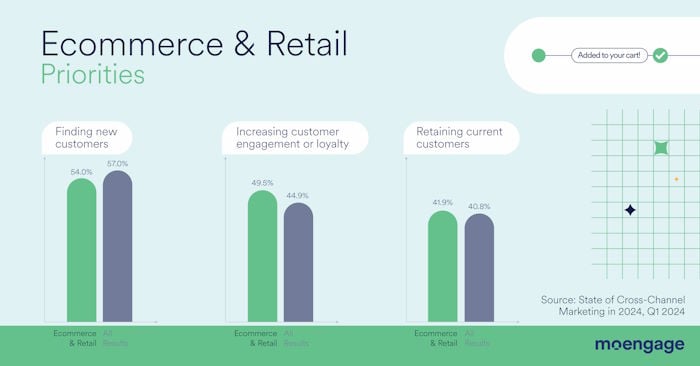
Ecommerce & Retail brands prioritize increasing customer engagement and retaining current customers, in addition to finding new customers. They recognize the importance of customer loyalty in a competitive market. Retaining existing customers is cost-effective and can lead to repeat purchases and word-of-mouth referrals, contributing to their emphasis on customer engagement.
Financial Services
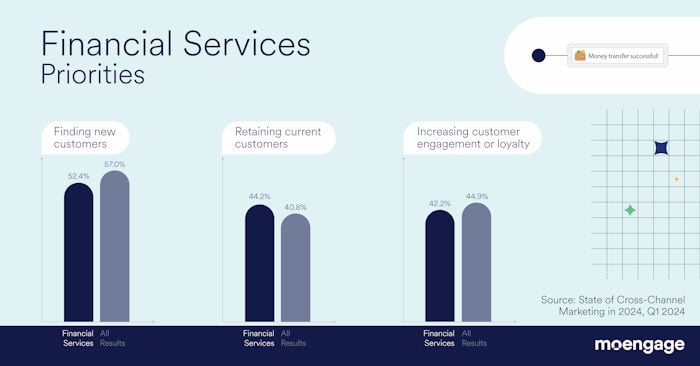
Financial Services brands prioritize retaining current customers over increasing engagement or loyalty. This is because these companies focus on cultivating long-term relationships that generate recurring revenue. With high acquisition costs and regulatory requirements, retaining existing customers is a cost-effective strategy in this industry.
Media & Entertainment

In the Media & Entertainment industry, increasing customer engagement and loyalty is crucial to stand out in a crowded market with extensive choices for consumers.
While attracting new customers is important, these brands prioritize understanding the optimal customer journey to provide seamless experiences across multiple platforms.
Retention may be less of a focus due to shifting customer preferences in this fast-paced industry. Continuously attracting and engaging both new and existing customers is seen as more beneficial than solely focusing on retention.
Food & Beverage
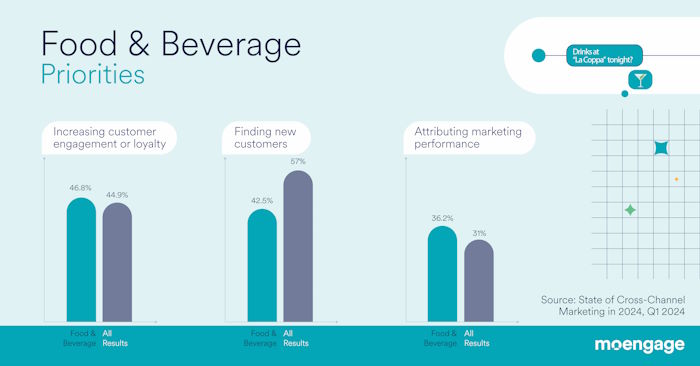
Food & Beverage brands prioritize increasing customer engagement and loyalty in 2024. While finding new customers is still important, it is not as immediate as in other industries. These brands prioritize attributing marketing performance, ahead of customer retention by about 5%.
Attributing marketing performance is crucial for Food & Beverage companies due to market competitiveness and slim profit margins. It helps optimize spend, increase returns, and gain insights into consumer behavior. While customer retention is important, the focus on marketing performance attribution is slightly higher to ensure competition and profitability in the industry.
Artificial Intelligence Usage by Industry
The recent surge in AI is set to transform customer interaction, with early effects being evident already. Expectedly, 66.6% of survey respondents believe that capabilities powered by AI are significant or extremely significant for their brand.
Here, we’ll look at the importance of AI and how AI is impacting businesses on an industry level.
Importance of AI
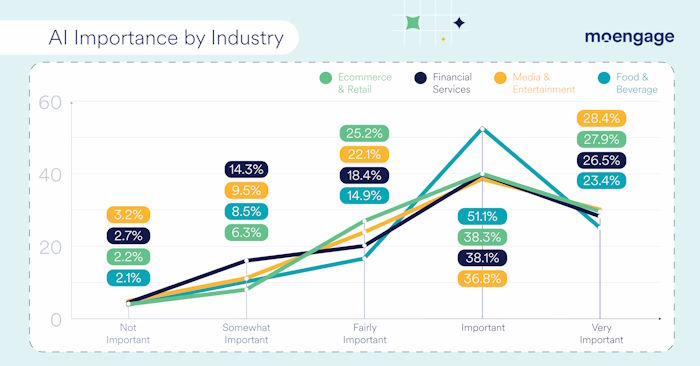
The graph shows a similar trend in the perceived importance of AI capabilities across all industries. The Food & Beverage industry stands out with a spike of 51.1% considering AI as “Important.”
This could be because the Food & Beverage industry faces unique challenges and opportunities where AI can provide significant advantages. These include supply chain optimization, predictive analytics for consumer behavior, and quality control.
How These Industries Use AI:
The top three use cases for AI in cross-channel marketing as a whole are:
- Generating and selecting content (33.2%)
- Creating AI-enhanced subject lines for better targeting (32.3%)
- Using AI-based Chatbots for instant customer interactions (28.4%)
In cross-channel marketing strategies, key AI use cases for Ecommerce & Retail and Financial Services brands are “AI-enhanced subject lines and targeting” and “AI Chatbots for instant customer interaction.”
Media & Entertainment organizations prioritize “AI for generating and selecting resonant content” and “AI-driven message customization for each customer.”
Food & Beverage companies primarily use AI for automated ad buying and personalization, which is unique to this sector. However, “AI for generating and selecting resonant content” is also a top priority for them.
Key Challenges by Industry
The current top three challenges for B2C marketers in driving customer engagement are:
- Budget and Resource Constraints (45.4%)
- Delivering Personalized Experiences (39.5%)
- Lack of Clarity Around Channel Performance (36.5%)
Also, marketers say that their biggest blind spots are the inability to react quickly enough to create timely, personalized cross-channel experiences (45.4%) and not knowing the long-term impacts of their customer engagement campaigns (42.7%).
How are these challenges impacting Ecommerce & Retail, Financial Services, Media & Entertainment, and Food & Beverage brands?
Ecommerce & Retail: Challenges and Blind Spots
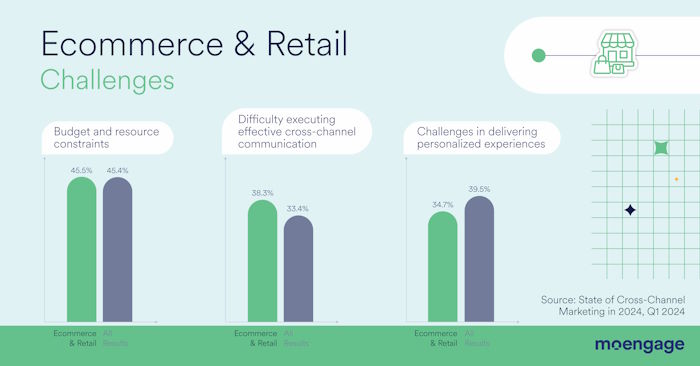
Both Ecommerce & Retail brands and the overall respondent group identify “budget and resource constraints” as their primary challenge.
Ecommerce & Retail businesses face a higher struggle with executing effective cross-channel communication (38.3%) compared to the general group (33.4%), likely due to the multitude of digital platforms used for customer engagement. However, they face fewer challenges in delivering personalized experiences (34.7% vs. 39.5%).
Ecommerce & Retail brands express greater concern about mapping the customer’s journey, with 33.8% citing it as a key challenge, compared to 26.6% of the total respondent group.
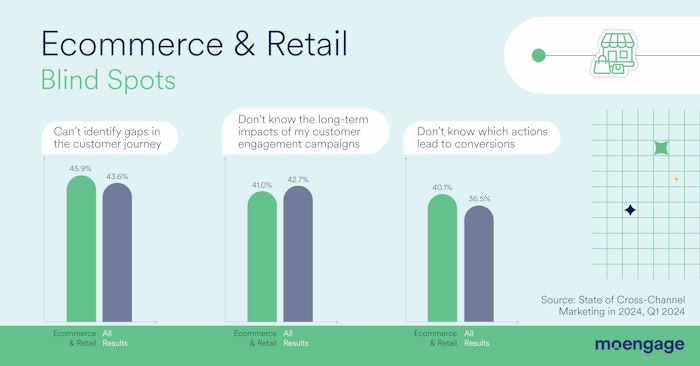
Ecommerce & Retail brands struggle with identifying gaps in the customer journey, while general respondents prioritize timely personalization (45.4%). Today’s digital platforms make the customer journey more complex, hindering the ability to track customer paths and understand campaign impacts.
However, Ecommerce & Retail companies have an advantage in reacting quickly and creating personalized experiences due to access to data and digital platform capabilities. These tools enable real-time analysis of consumer behavior for immediate and personalized responses.
Financial Services: Challenges and Blind Spots
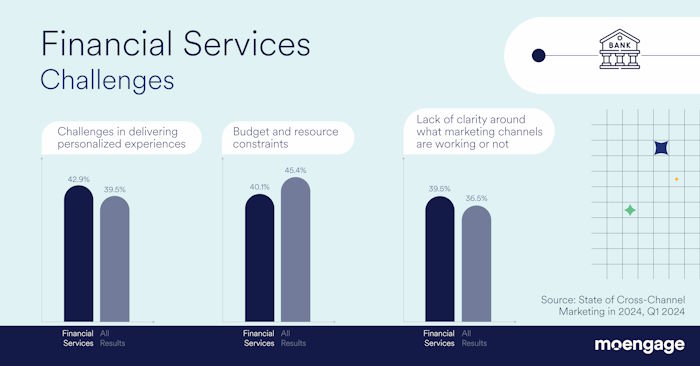
Financial Services businesses prioritize personalized experiences (42.9%) and understanding marketing channel effectiveness. The industry’s nature, dealing with customer assets and high expectations, makes personalization challenging due to sensitive financial data.
Budget constraints are less significant in Financial Services, and the competitive landscape drives the need for optimizing marketing spend and ensuring high ROI. Stringent regulations and compliance further emphasize the importance of clarity on marketing channel effectiveness.

Over 50% of Financial Services respondents struggle with understanding the long-term impacts of customer engagement campaigns, compared to 42.7% of the total group. They place less significance on identifying gaps in the customer journey (39.5%).
The industry’s focus on long-term relationships and challenges in measuring loyalty and lifetime value contribute to this blind spot. Financial Services organizations may have robust systems in place for a smooth customer journey, reducing the potential for significant gaps due to the regulated nature of the industry and sensitive financial data.
Media & Entertainment: Challenges and Blind Spots
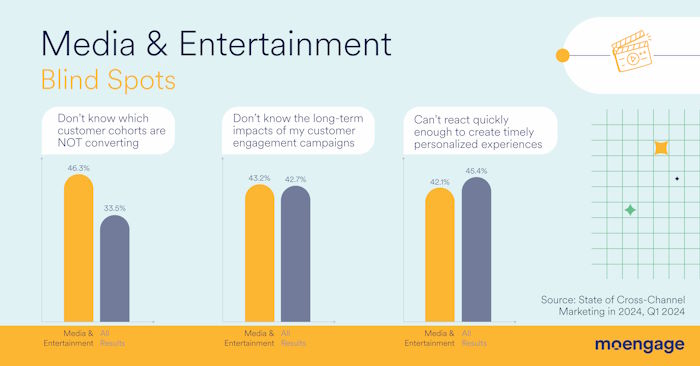
Budget constraints (48.4%) hinder growth and investment in cross-channel marketing and customer engagement in the Media & Entertainment industry. Producing, promoting, and distributing quality content across multiple channels is costly, and high acquisition costs add to the financial challenges. The industry’s rapid pace and need for innovation further strain budgets.
Additionally, 44.2% of brands struggle to understand effective marketing channels. The multitude of platforms used for content distribution makes it difficult to attribute success to a single channel, especially with customers interacting across multiple touchpoints.
Executing effective cross-channel communication is also challenging. Delivering a consistent and personalized message across diverse platforms and devices (social media, streaming platforms, traditional TV, radio) is complex, especially considering the wide-reaching and diverse audience these brands cater to.
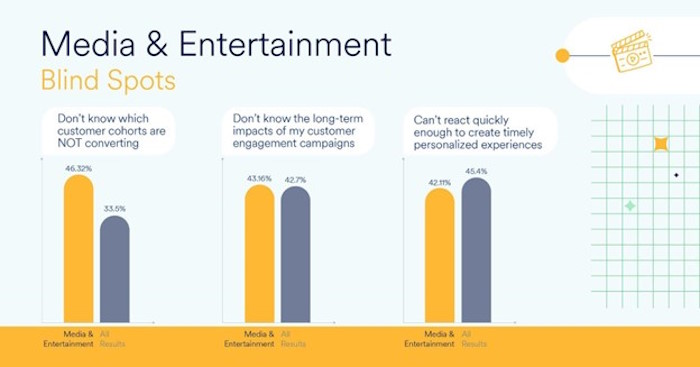
Given the challenges highlighted earlier, it’s understandable why nearly half of Media & Entertainment companies are struggling to identify which customer cohorts aren’t converting (46.3%).
The industry’s diverse audience base and the multitude of platforms and channels used for content consumption can make it difficult to pinpoint specific customer segments that aren’t engaging or converting as expected. Also, the multiple touchpoints and potential paths to conversion can make it challenging to measure and analyze the behavior of distinct cohorts effectively.
Food & Beverage: Challenges and Blind Spots
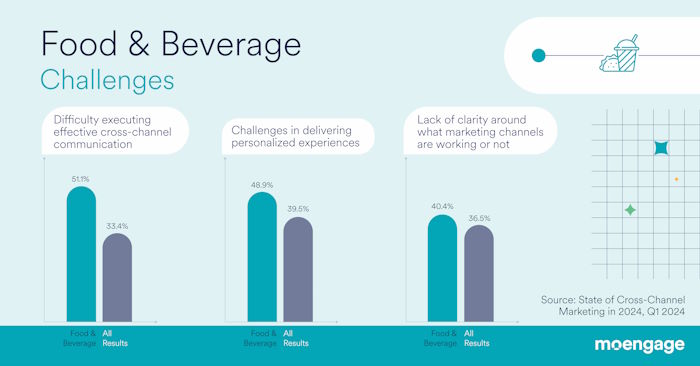
Unlike other industries, Food & Beverage brands do not consider budget constraints as a top challenge.
The primary issue in the Food & Beverage space is executing effective cross-channel communication, with 51.1% of respondents citing this as a challenge, compared to 33.4% of general respondents.
This could be attributed to lower marketing budgets in the industry, as Food & Beverage brands often rely on product quality, location, and word-of-mouth marketing.
However, the difficulty in executing cross-channel communication aligns with the industry’s customer engagement needs. Food & Beverage brands must maintain a consistent and engaging presence across various channels, including social media, email marketing, websites, mobile apps, and physical locations.
The customer journey in this industry involves multiple touchpoints, from online recipe blogs to in-store tastings, making cross-channel communication complex. Additionally, customer preferences in the Food & Beverage industry can vary greatly, adding to the challenge of crafting messages that resonate across different channels.
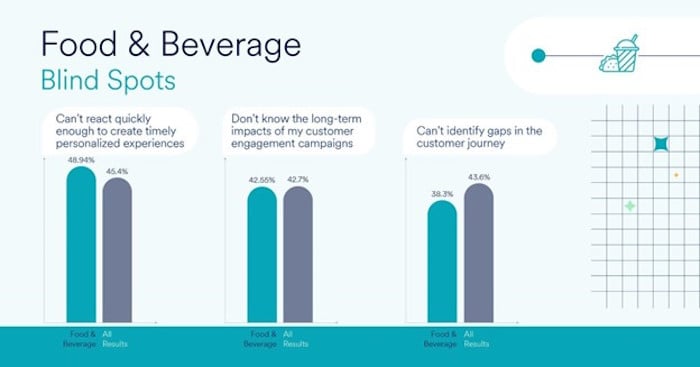
As far as blind spots go, 48.9% of Food & Beverage businesses said they can’t react quickly enough to create timely personalized experiences, which is in line with the general group of respondents.
In the Food & Beverage industry, trends and consumer tastes can change rapidly. Seasonality, dietary preferences, new cooking techniques, and even food-related viral social media trends can all influence consumer behavior. As a result, Food & Beverage businesses need to be highly responsive and adapt quickly to keep up with these shifts.
What is the #1 Thing that Leads to Successful Cross-Channel Marketing Campaigns?
In light of the escalating complexity in marketing due to evolving consumer behaviors and industry transformations, marketers are progressively turning to analytics to construct large-scale cross-channel marketing campaigns and evaluate their overall effectiveness.
When questioned about the most significant element in creating a successful cross-channel marketing approach, 33.1% of B2C marketers pointed to “leveraging customer data analytics for making targeted marketing decisions.”
All industries followed suit and selected this as their #1 response.
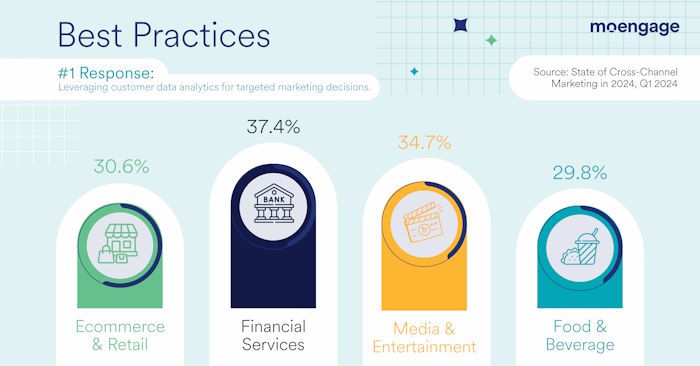
This highlights the growing recognition of the power of customer data analytics in shaping and driving successful marketing strategies, regardless of the industry.
It goes beyond merely collecting vast amounts of customer data; it’s about capitalizing on that data to comprehend customer behaviors, preferences, and trends. This understanding forms the basis of effective cross-channel marketing strategies, enabling businesses to deliver personalized experiences aligned with customer expectations.
The unanimous selection of customer data analytics as a leading tool across all industries in this study highlights its universal significance in today’s marketing environment. It demonstrates that leveraging technology for customer engagement, marketing automation, data analytics, and cross-channel communication is indispensable for businesses aiming to stand out and succeed in the complicated and rapidly evolving world of B2C marketing.



![[Book Review] Jonah Berger Unveils the Hidden Power of Words](https://customerthink.com/wp-content/uploads/offer-ga95283b29_1280-pixabay-marketing-loyalty-218x150.jpg)